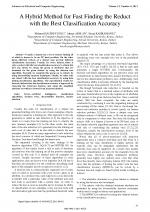| 4/2013 - 10 |
A Hybrid Method for Fast Finding the Reduct with the Best Classification AccuracyHACIBEYOGLU, M. |
| View the paper record and citations in |
| Click to see author's profile in |
| Download PDF |
Author keywords
artificial intelligence, classification algorithms, decision trees, discernibility function, feature selection
References keywords
rough(13), data(13), systems(11), knowledge(11), information(11), rule(10), learning(10), induction(10), approach(8), classification(7)
No common words between the references section and the paper title.
About this article
Date of Publication: 2013-11-30
Volume 13, Issue 4, Year 2013, On page(s): 57 - 64
ISSN: 1582-7445, e-ISSN: 1844-7600
Digital Object Identifier: 10.4316/AECE.2013.04010
Web of Science Accession Number: 000331461300010
SCOPUS ID: 84890203115
Abstract
Usually a dataset has a lot of reducts finding all of which is known to be an NP hard problem. On the other hand, different reducts of a dataset may provide different classification accuracies. Usually, for every dataset, there is only a reduct with the best classification accuracy to obtain this best one, firstly we obtain the group of attributes that are dominant for the given dataset by using the decision tree algorithm. Secondly we complete this group up to reducts by using discernibility function techniques. Finally, we select only one reduct with the best classification accuracy by using data mining classification algorithms. The experimental results for datasets indicate that the classification accuracy is improved by removing the irrelevant features and using the simplified attribute set which is derived from proposed method. |
| References | | | Cited By |
Web of Science® Times Cited: 5 [View]
View record in Web of Science® [View]
View Related Records® [View]
Updated today
SCOPUS® Times Cited: 5
View record in SCOPUS® [Free preview]
View citations in SCOPUS® [Free preview]
[1] Prediction of users webpage access behaviour using association rule mining, GEETHARAMANI, R, REVATHY, P, JACOB, SHOMONA G, Sadhana, ISSN 0256-2499, Issue 8, Volume 40, 2015.
Digital Object Identifier: 10.1007/s12046-015-0424-0 [CrossRef]
[2] The logic transformations for reducing the complexity of the discernibility function-based attribute reduction problem, Hacibeyoglu, Mehmet, Salman, Mohammad Shukri, Selek, Murat, Kahramanli, Sirzat, Knowledge and Information Systems, ISSN 0219-1377, Issue 3, Volume 46, 2016.
Digital Object Identifier: 10.1007/s10115-015-0824-9 [CrossRef]
[3] Automatic Mining of Numerical Classification Rules with Parliamentary Optimization Algorithm, KIZILOLUK, S., ALATAS, B., Advances in Electrical and Computer Engineering, ISSN 1582-7445, Issue 4, Volume 15, 2015.
Digital Object Identifier: 10.4316/AECE.2015.04003 [CrossRef] [Full text]
Disclaimer: All information displayed above was retrieved by using remote connections to respective databases. For the best user experience, we update all data by using background processes, and use caches in order to reduce the load on the servers we retrieve the information from. As we have no control on the availability of the database servers and sometimes the Internet connectivity may be affected, we do not guarantee the information is correct or complete. For the most accurate data, please always consult the database sites directly. Some external links require authentication or an institutional subscription.
Web of Science® is a registered trademark of Clarivate Analytics, Scopus® is a registered trademark of Elsevier B.V., other product names, company names, brand names, trademarks and logos are the property of their respective owners.
Faculty of Electrical Engineering and Computer Science
Stefan cel Mare University of Suceava, Romania
All rights reserved: Advances in Electrical and Computer Engineering is a registered trademark of the Stefan cel Mare University of Suceava. No part of this publication may be reproduced, stored in a retrieval system, photocopied, recorded or archived, without the written permission from the Editor. When authors submit their papers for publication, they agree that the copyright for their article be transferred to the Faculty of Electrical Engineering and Computer Science, Stefan cel Mare University of Suceava, Romania, if and only if the articles are accepted for publication. The copyright covers the exclusive rights to reproduce and distribute the article, including reprints and translations.
Permission for other use: The copyright owner's consent does not extend to copying for general distribution, for promotion, for creating new works, or for resale. Specific written permission must be obtained from the Editor for such copying. Direct linking to files hosted on this website is strictly prohibited.
Disclaimer: Whilst every effort is made by the publishers and editorial board to see that no inaccurate or misleading data, opinions or statements appear in this journal, they wish to make it clear that all information and opinions formulated in the articles, as well as linguistic accuracy, are the sole responsibility of the author.





